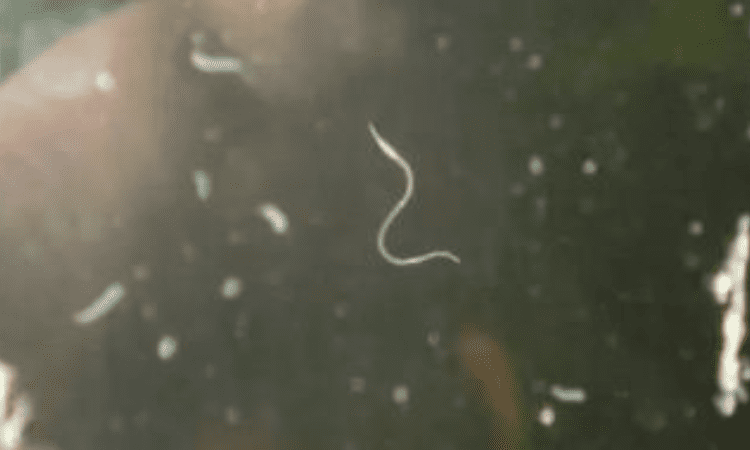Unexpected worms in your tank, be it freshwater or saltwater, understandably set off alarm bells. However, only a few aquatic worm species actually harm fish or live plants. Learning proper identification and control methods helps assess true risks. This guide explores common aquarium worms, damages they cause, and eradication techniques.
Detritus Worms
Detritus worms (Oligochaeta) rank among the most prolific aquarium worms.
Identifying Traits
These thin, white segmented worms reach just 1⁄4-1⁄2 inch long. They tunnel through substrate consuming trapped organic debris and algae. Detritus worms harmlessly aid the nitrogen cycle and indicate established aquariums.
Population Explosions
Overpopulations typically signal excess rotting waste accumulation and insufficient tank maintenance. High numbers appear unsightly but don’t directly damage fish or plants.
Control Strategies
Perform thorough gravel vacuuming during water changes to manually remove worms and decrease food sources. Cut back on feedings as well. Using substrates like sand limits multiply niches compared to gravel. Adding bottom feeders helps control populations through predation too.
Planaria
Planaria (Dugesia dorotocephala) pose threats, especially in shrimp tanks, with voracious appetites.
Identifying Traits
Greyish-white flatworms with arrow shaped heads and two eye spots characterize these primitive worms up to 2 inches long. They glide along hard surfaces scavenging anything edible.
Hazards Posed
Planaria feast upon shrimp, small fish eggs and vulnerable fry. They reproduce through binary fission, rapidly exponentially increasing in number if left uncontrolled.
Eradicating Techniques
Manual removal offers little lasting success against planaria. Instead use chemical treatments containing betel/areca nut extract (like No Planaria or Planaria Zero). Perform water testing before and after treatment since these products can impact water parameters temporarily. Avoid keeping sensitive invertebrates during treatment.
Camallanus Roundworms
This nasty parasitic nematode notoriously plagues freshwater species.
Identifying Traits
Pinkish-red threads around 0.5 inch long protruding from fish anuses or seen dangling from stomachs characterize Camallanus infestations. Infected fish often display sunken bellies, lethargy, weakened immune systems and appetite loss.
Hazards Posed
A highly contagious parasite, Camallanus punctures intestinal walls causing internal damage, organ dysfunction, secondary infections and eventually death if not addressed.
Treatment Options
Use levamisole hydrochloride (Lev-M) tablets or solutions like Ruby Reef Kick-Ich. Quarantine and treat infected fish. Also treat the main tank with appropriate anti-parasitic medications to prevent further spread or reinfection. Thoroughly sanitize the aquarium afterwards.
Conclusion
Learning to promptly identify aquarium worms helps assess true risks posed. While most remain harmless, predatory species like planaria and parasitic roundworms require swift removal to protect livestock. Combining water parameter testing, manual removal methods, chemical treatments and tank sanitation ensures successful worm eradication without resorting immediately to break-downs when worms appear unexpectedly.
FAQs About Controlling Aquarium Worms
1. How do fish get harmful worms?
Worm parasites and other illnesses often get introduced through infected new fish, plants or untreated feeding items. Always quarantine new arrivals and sanitize gear between tank uses.
2. Can aquarium salt kill worms?
While salt dips may displace some external parasites, salts do not kill resilient worms burrowed in substrate or within fish intestinal tracts. Use targeted anti-parasitic chemical treatments instead for these.
3. Do worm infestations go away on their own?
Left unchecked species like planaria or Camallanus will proliferate rapidly to overwhelming infestation levels. Timely treatment remains essential to curb exponential population growth and transmission between tank inhabitants.
4. Can fish recover from intestinal worms?
Fish infected with parasitic gut worms can fully recover following successful treatment. However, left long term the resulting organ damage makes death inevitable. Monitor during recovery to ensure worm elimination.
5. How do I know worm treatment worked?
Post-treatment you want to see worms fully eliminated based on observation, improved appetite and energy levels in infected fish. Repeat doses or alternative medications as per product instructions if worms persist. Perform follow up fecal examinations using microscopy when possible. Absence confirms success.





